Java 基于 Socket 文件传输示例
1.服务器端
package sterning;
import java.io.BufferedInputStream;
import java.io.DataInputStream;
import java.io.DataOutputStream;
import java.io.File;
import java.io.FileInputStream;
import java.net.ServerSocket;
import java.net.Socket;
public class ServerTest {
int port = 8821;
void start() {
Socket s = null;
try {
ServerSocket ss = new ServerSocket(port);
while (true) {
// 选择进行传输的文件
String filePath = "D:\\lib.rar";
File fi = new File(filePath);
System.out.println("文件长度:" + (int)
// public Socket accept() throws
// IOException 侦听并接受到此套接字的连
fi.length());
接。此方法在进行连接之前一直阻塞。
s = ss.accept();
System.out.println("建立 socket 链接");
DataInputStream dis = new
DataInputStream(new BufferedInputStream(s.getInputStream()));
dis.readByte();
DataInputStream fis = new
DataInputStream(new BufferedInputStream(new
FileInputStream(filePath)));
DataOutputStream ps = new
DataOutputStream(s.getOutputStream());
//将文件名及长度传给客户端。这里要真正
适用所有平台,例如中文名的处理,还需要加工,具体可以参见 Think In Java
�
4th 里有现成的代码。
等待 server 的数据过来,
整。
ps.writeUTF(fi.getName());
ps.flush();
ps.writeLong((long) fi.length());
ps.flush();
int bufferSize = 8192;
byte[] buf = new byte[bufferSize];
while (true) {
int read = 0;
if (fis != null) {
read = fis.read(buf);
}
if (read == -1) {
break;
}
ps.write(buf, 0, read);
}
ps.flush();
// 注意关闭 socket 链接哦,不然客户端会
// 直到 socket 超时,导致数据不完
fis.close();
s.close();
System.out.println("文件传输完成");
}
} catch (Exception e) {
e.printStackTrace();
}
}
public static void main(String arg[]) {
new ServerTest().start();
}
}
2.socket 的 Util 辅助类
package sterning;
�
import java.net.*;
import java.io.*;
public class ClientSocket {
private String ip;
private int port;
private Socket socket = null;
DataOutputStream out = null;
DataInputStream getMessageStream = null;
public ClientSocket(String ip, int port) {
this.ip = ip;
this.port = port;
}
/** *//**
* 创建 socket 连接
*
* @throws Exception
*
*/
exception
public void CreateConnection() throws Exception {
try {
socket = new Socket(ip, port);
} catch (Exception e) {
e.printStackTrace();
if (socket != null)
socket.close();
throw e;
} finally {
}
}
public void sendMessage(String sendMessage) throws Exception {
try {
out = new
DataOutputStream(socket.getOutputStream());
if (sendMessage.equals("Windows")) {
out.writeByte(0x1);
out.flush();
return;
�
}
if (sendMessage.equals("Unix")) {
out.writeByte(0x2);
out.flush();
return;
}
if (sendMessage.equals("Linux")) {
out.writeByte(0x3);
out.flush();
} else {
out.writeUTF(sendMessage);
out.flush();
}
} catch (Exception e) {
e.printStackTrace();
if (out != null)
out.close();
throw e;
} finally {
}
}
public DataInputStream getMessageStream() throws Exception {
try {
getMessageStream = new DataInputStream(new
BufferedInputStream(socket.getInputStream()));
return getMessageStream;
} catch (Exception e) {
e.printStackTrace();
if (getMessageStream != null)
getMessageStream.close();
throw e;
} finally {
}
}
public void shutDownConnection() {
try {
if (out != null)
out.close();
if (getMessageStream != null)
getMessageStream.close();
if (socket != null)
socket.close();
�
} catch (Exception e) {
}
}
}
3.客户端
package sterning;
import java.io.BufferedOutputStream;
import java.io.DataInputStream;
import java.io.DataOutputStream;
import java.io.FileOutputStream;
public class ClientTest {
private ClientSocket cs = null;
private String ip = "localhost";// 设置成服务器 IP
private int port = 8821;
private String sendMessage = "Windwos";
public ClientTest() {
try {
if (createConnection()) {
sendMessage();
getMessage();
}
} catch (Exception ex) {
ex.printStackTrace();
}
}
private boolean createConnection() {
cs = new ClientSocket(ip, port);
try {
cs.CreateConnection();
System.out.print("连接服务器成功!" + "\n");
return true;
} catch (Exception e) {
System.out.print("连接服务器失败!" + "\n");
return false;
�
}
}
private void sendMessage() {
if (cs == null)
return;
try {
cs.sendMessage(sendMessage);
} catch (Exception e) {
System.out.print("发送消息失败!" + "\n");
}
}
private void getMessage() {
if (cs == null)
return;
DataInputStream inputStream = null;
try {
inputStream = cs.getMessageStream();
} catch (Exception e) {
System.out.print("接收消息缓存错误\n");
return;
}
try {
//本地保存路径,文件名会自动从服务器端继承而来。
String savePath = "E:\\";
int bufferSize = 8192;
byte[] buf = new byte[bufferSize];
int passedlen = 0;
long len=0;
savePath += inputStream.readUTF();
DataOutputStream fileOut = new
DataOutputStream(new BufferedOutputStream(new BufferedOutputStream(new
FileOutputStream(savePath))));
len = inputStream.readLong();
"\n");
System.out.println("文件的长度为:" + len +
System.out.println("开始接收文件!" + "\n");
while (true) {
�
int read = 0;
if (inputStream != null) {
read = inputStream.read(buf);
}
passedlen += read;
if (read == -1) {
break;
}
//下面进度条本为图形界面的 prograssBar
做的,这里如果是打文件,可能会重复打印出一些相同的百分比
System.out.println("文件接收了" +
(passedlen * 100/ len) + "%\n");
fileOut.write(buf, 0, read);
}
System.out.println("接收完成,文件存为" +
savePath + "\n");
fileOut.close();
} catch (Exception e) {
System.out.println("接收消息错误" + "\n");
return;
}
}
public static void main(String arg[]) {
new ClientTest();
}
}
�
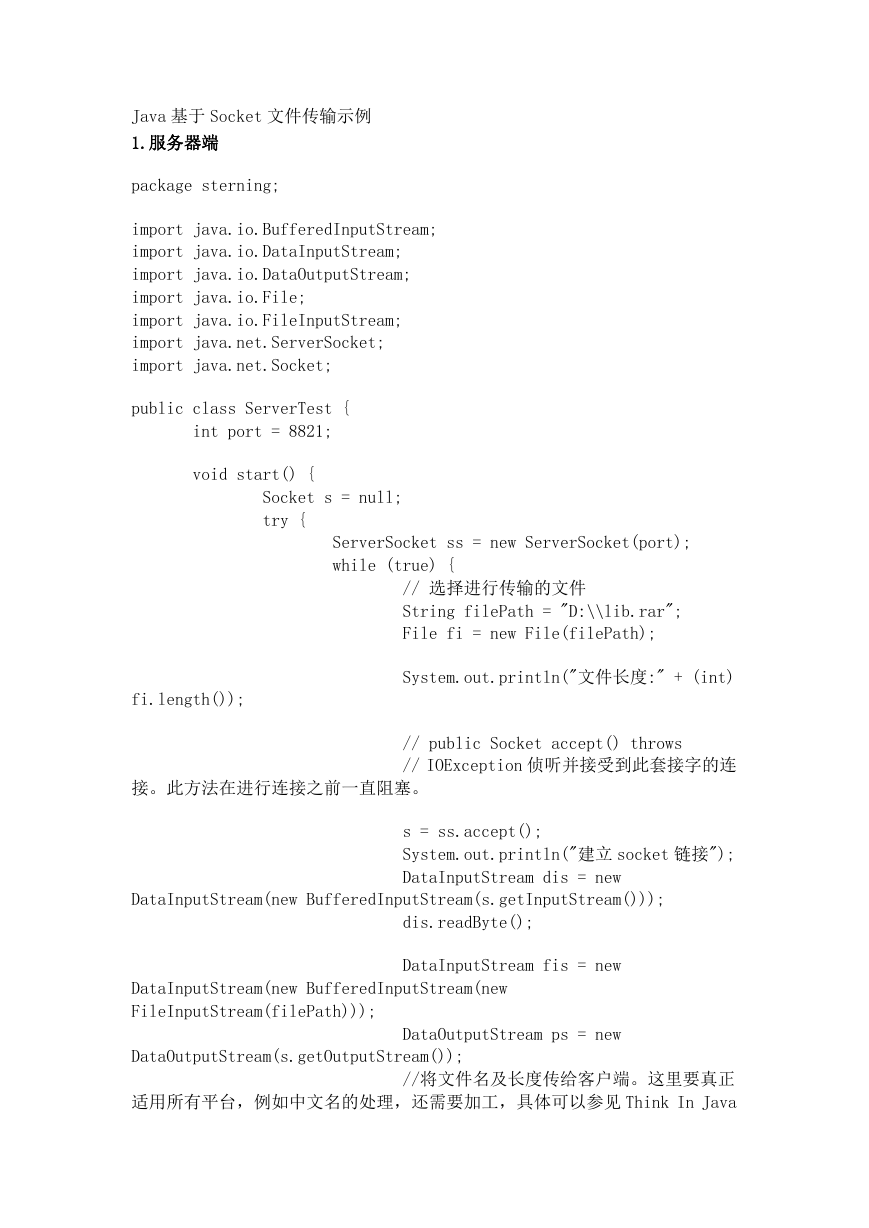
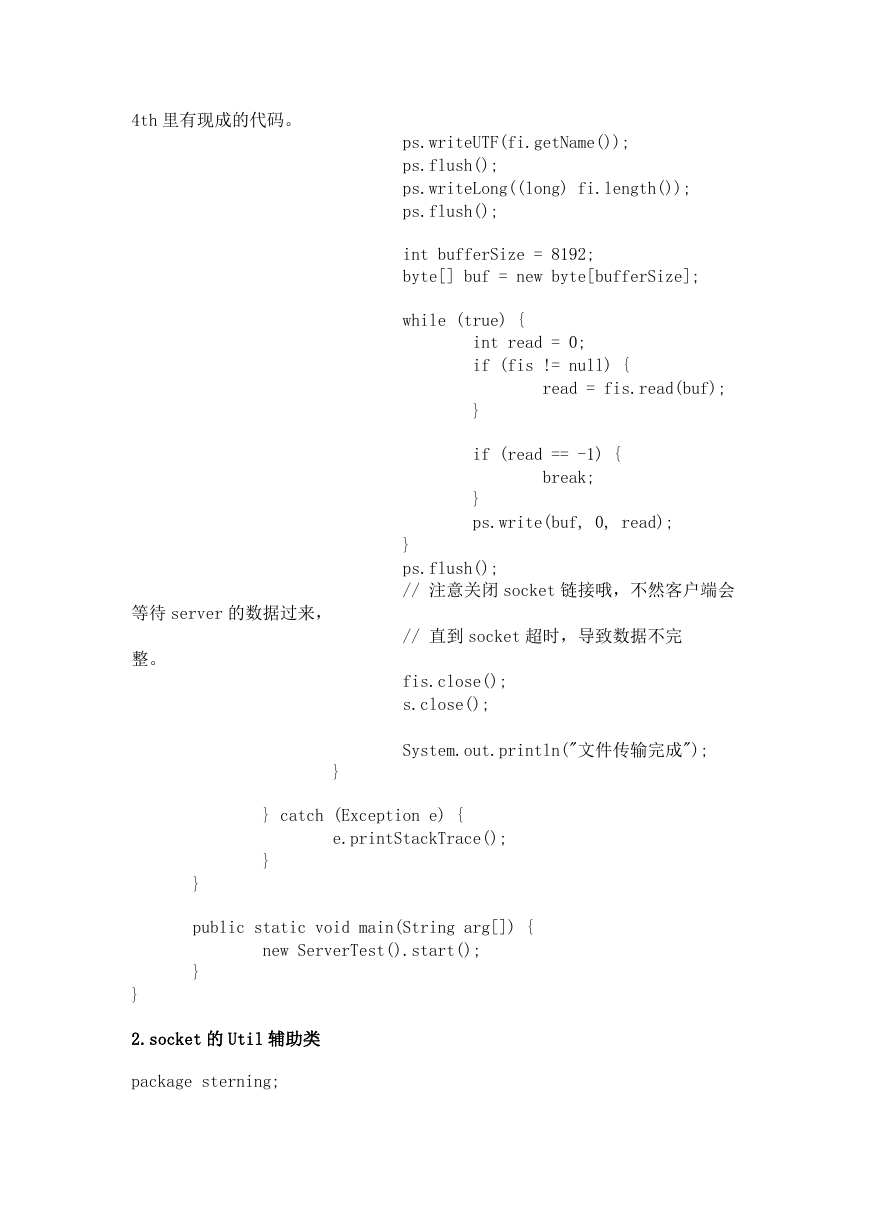
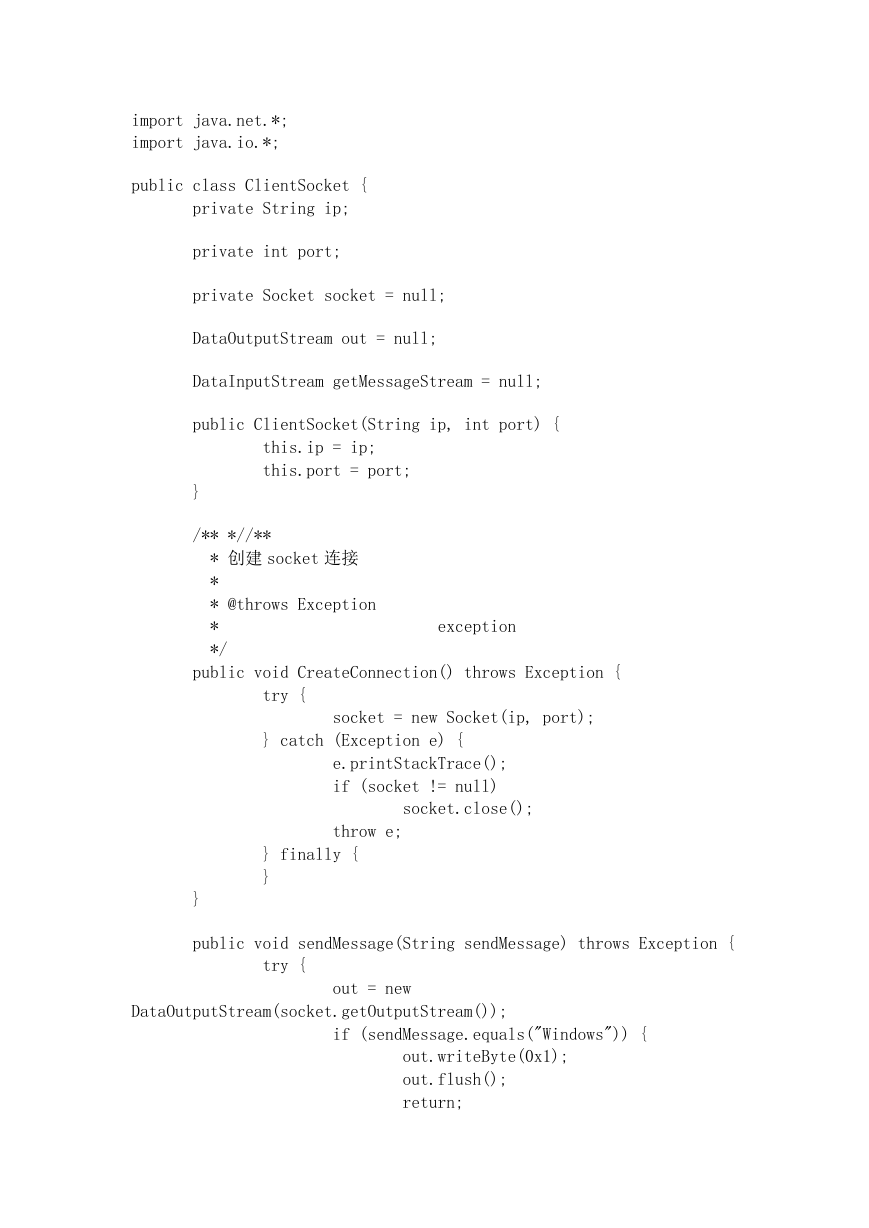
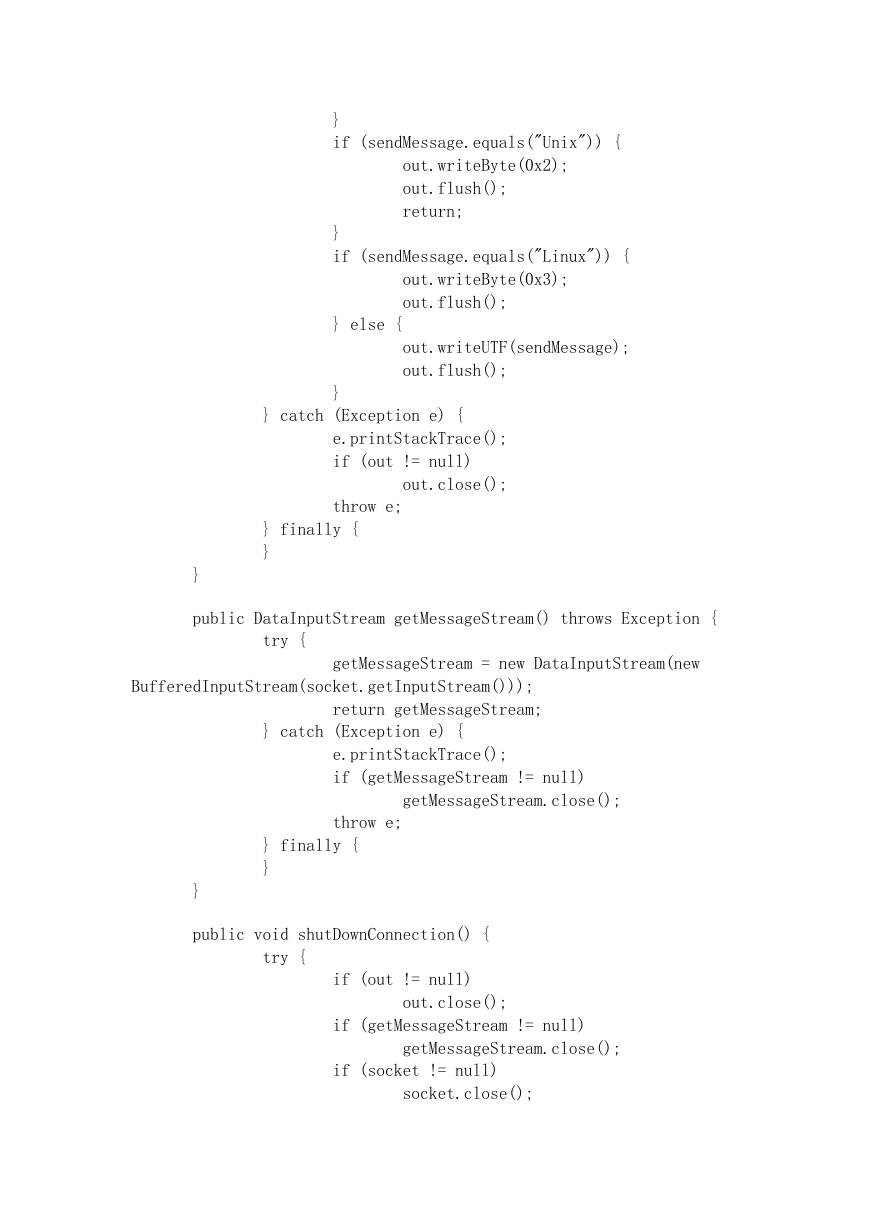
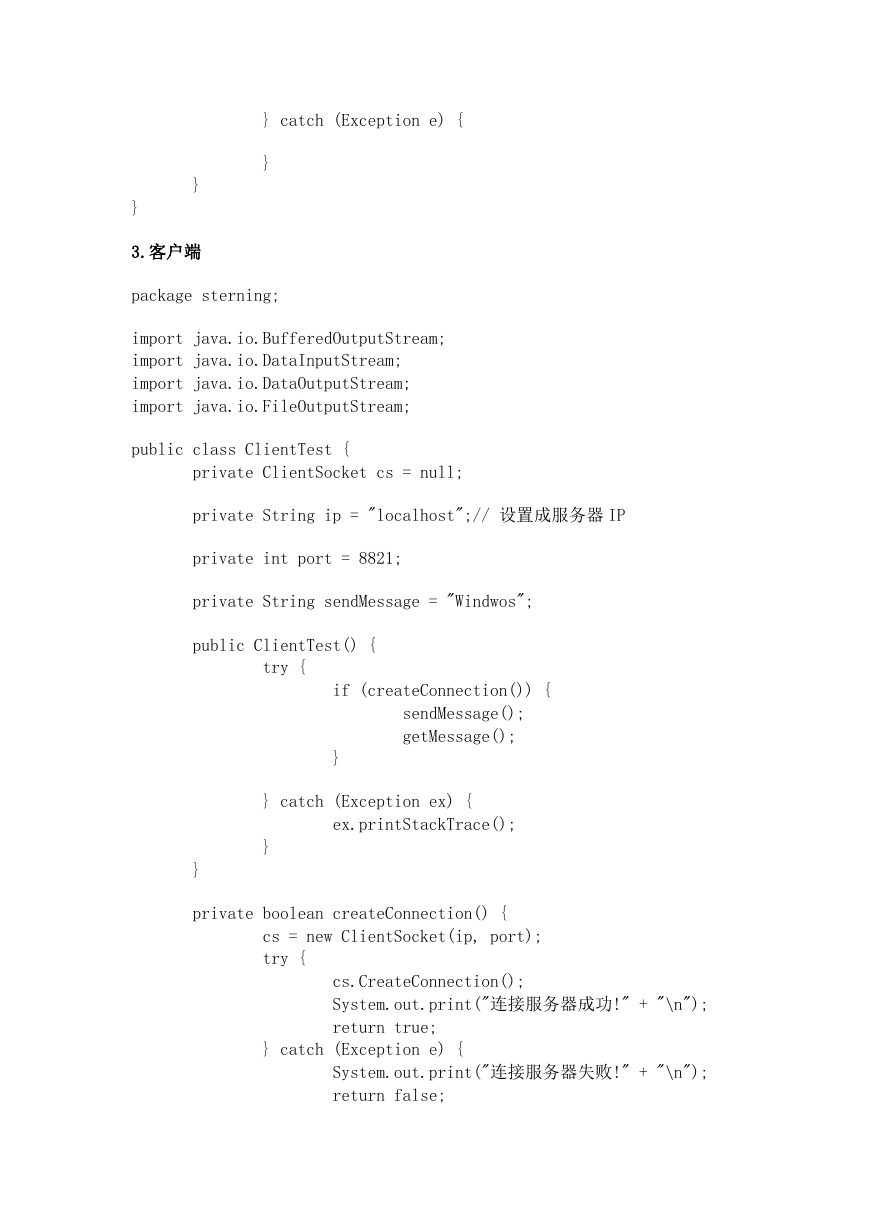
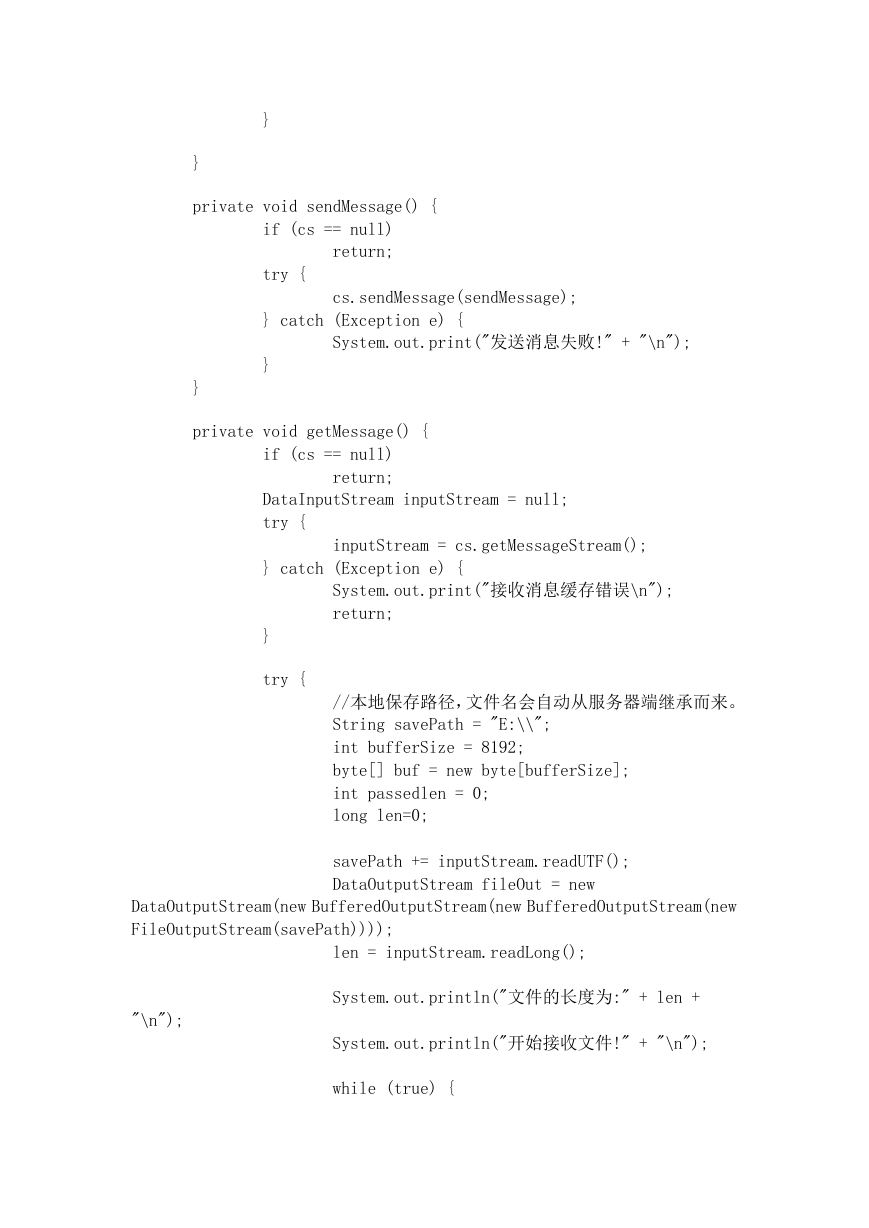
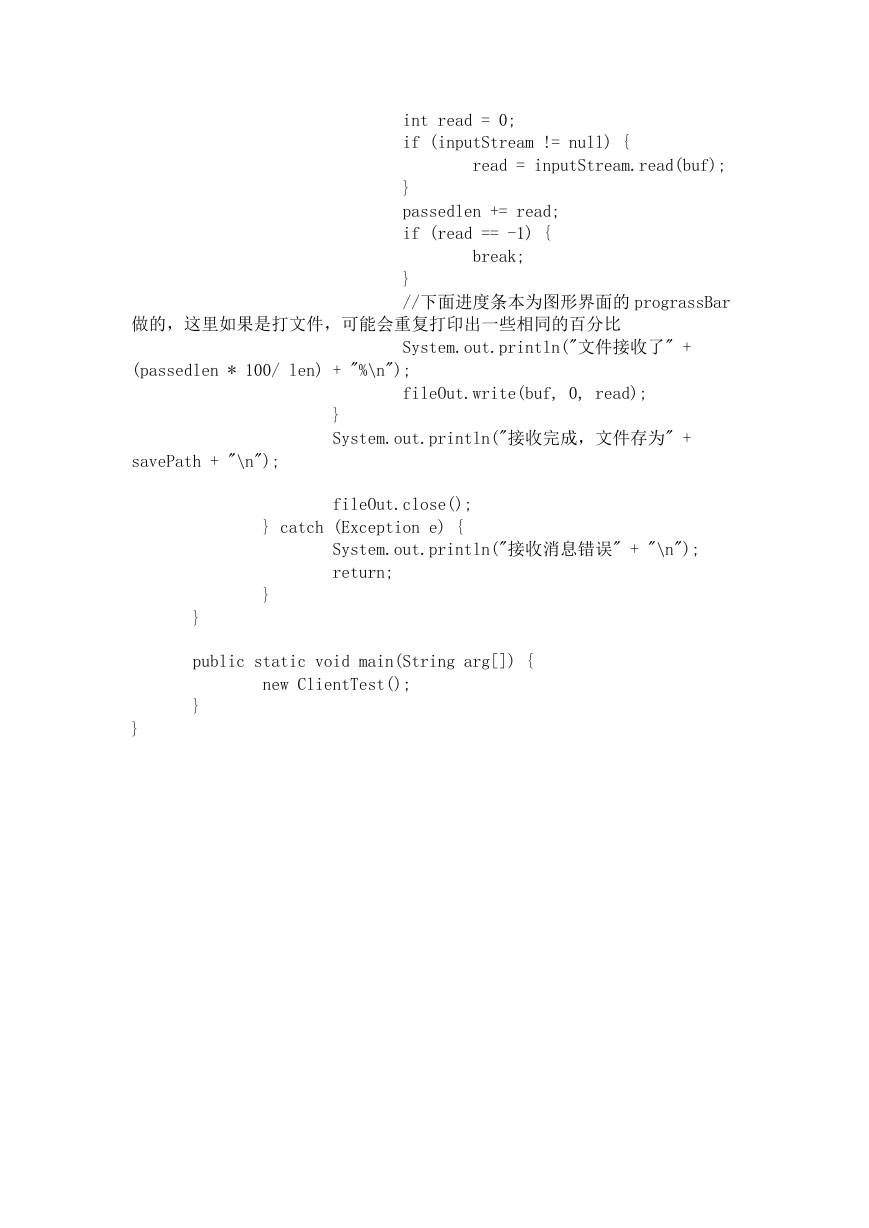







 2023年江西萍乡中考道德与法治真题及答案.doc
2023年江西萍乡中考道德与法治真题及答案.doc 2012年重庆南川中考生物真题及答案.doc
2012年重庆南川中考生物真题及答案.doc 2013年江西师范大学地理学综合及文艺理论基础考研真题.doc
2013年江西师范大学地理学综合及文艺理论基础考研真题.doc 2020年四川甘孜小升初语文真题及答案I卷.doc
2020年四川甘孜小升初语文真题及答案I卷.doc 2020年注册岩土工程师专业基础考试真题及答案.doc
2020年注册岩土工程师专业基础考试真题及答案.doc 2023-2024学年福建省厦门市九年级上学期数学月考试题及答案.doc
2023-2024学年福建省厦门市九年级上学期数学月考试题及答案.doc 2021-2022学年辽宁省沈阳市大东区九年级上学期语文期末试题及答案.doc
2021-2022学年辽宁省沈阳市大东区九年级上学期语文期末试题及答案.doc 2022-2023学年北京东城区初三第一学期物理期末试卷及答案.doc
2022-2023学年北京东城区初三第一学期物理期末试卷及答案.doc 2018上半年江西教师资格初中地理学科知识与教学能力真题及答案.doc
2018上半年江西教师资格初中地理学科知识与教学能力真题及答案.doc 2012年河北国家公务员申论考试真题及答案-省级.doc
2012年河北国家公务员申论考试真题及答案-省级.doc 2020-2021学年江苏省扬州市江都区邵樊片九年级上学期数学第一次质量检测试题及答案.doc
2020-2021学年江苏省扬州市江都区邵樊片九年级上学期数学第一次质量检测试题及答案.doc 2022下半年黑龙江教师资格证中学综合素质真题及答案.doc
2022下半年黑龙江教师资格证中学综合素质真题及答案.doc